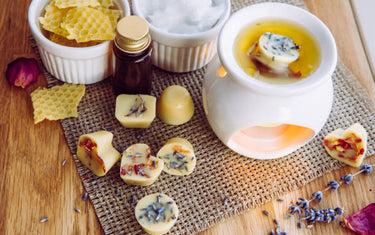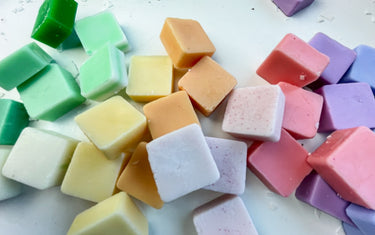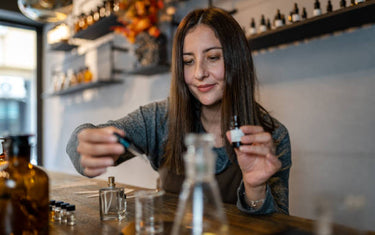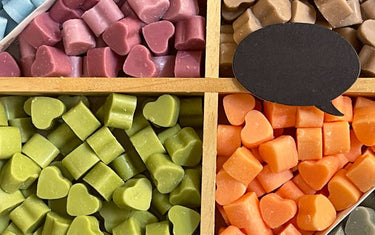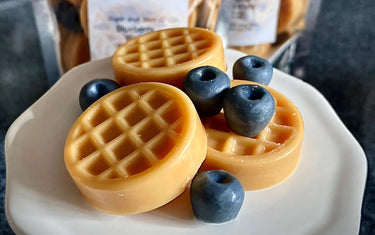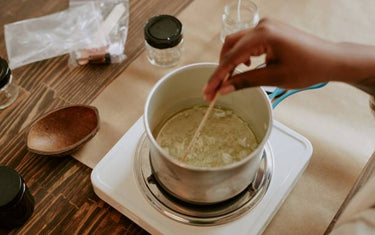10 min read / 24 February 2025 / yasmin sharp
6. Wax Melts Safety and Legal Considerations
Learn how to safely make wax melts with our guide on handling materials, IFRA guidelines, labelling requirements, and legal regulations for selling.
Share this post

Making and selling wax melts and candles at home allows you to get creative and earn some extra cash along the way.
There are also some important safety and legal considerations that need to be considered to ensure that both you and your customers have the right kinds of protections in place.
Even if you are only making wax melts for personal use, the health and safety aspects are still something you will need to pay close attention to.
In this guide we explain more about CLP labelling for wax melts, what safety measures you can put in place, other relevant legal guidelines you need to consider and how all of this can help you improve the quality of your melts.

1. Handling Materials Safely
When making wax melts, safety should always be your first priority. Here are some key points to consider when working with wax and fragrance oils:
Working with wax
Monitoring the melting temperature enhances your safety when making wax melts. Wax that is too hot can make it splash and burn the skin, whilst also creating potential fire hazards, as overheated wax is more flammable.
Wax melting tips
When heating your wax using a double boiler or melting pot, follow the steps below to keep yourself safe:
- Fill the large pot with 1-2 inches of water. Using a medium heat bring the water to a gentle simmer.
- Place the heat-safe container on top of the pot, ensuring that it does not touch the water.
- Pour the candle wax into the container.
- Using a wooden spoon, slowly stir and monitor the wax as it melts.
- Aim to keep the temperature between 160°F to 180°F to avoid burning.
- Once the wax has melted and it has reached your ideal temperature, use oven gloves to carefully remove the container from the pot.
- Turn off the heat and carefully dispose of the boiling water in the sink.
Proper ventilation
Ensure that you work in a space that has proper ventilation to avoid inhaling any fumes that may be released when you are making your wax melts.
Open nearby windows to create good air flow and air circulation, which will allow emissions from fragrances, dyes and waxes to filter out and reduce exposure to pollutants.
Safe Use of Fragrance Oils
Whether you are using fragrance oils or essential oils for your wax melts, take the following into consideration:
- Use protective gloves and eyewear to prevent irritation.
- Wear long sleeve clothing to avoid direct skin contact with concentrated oils.
- Avoid open flames and do not smoke.
- Wash your hands thoroughly after handling the oils.
- Do not pour the oils directly into drains or watercourses.
Storage and Disposal
Safe storage and disposal of your oils will not only keep you safe but also ensure no damage is caused to the wider environment.
- Wax melt storage: If storing wax melts in deli pots or clam shells, store these in the same way at scented candles inside large plastic containers with lids. Use glassine bags placed in small segment boxes on cardboard trays to protect wax melts made with a silicone mould. Vertical storage will help to prevent uneven movement of the fragrance oils.
- Fragrance and essential oil storage: Put the oils into dark, cobalt and amber glass bottles, which will give them protection against heat sources and UV rays. Store them in a dry, cool area – a cupboard, shelf or drawer for example – away from indoor heat sources and direct sunlight. Alternatively, you can also store them in the fridge. Most fragrance oils last between 1-2 years, whilst essential oils can last up to 8 years, so keep track of the dates so you have a good idea of their freshness.
Fragrance and essential oil disposal
If you want to dispose of any oils, try to avoid the following:
- Fragrance and essential oils are highly concentrated and should never be poured down the drain as they can contaminate water supplies and harm aquatic life.
- They are also flammable and can release harmful chemicals in landfills, so do not throw them away in your rubbish bin.
To dispose your oils safely, you can:
- Check the label to see if there are any specific disposal instructions that need to be followed.
- Bring unwanted oils to your local hazardous waste facility where they can be dealt with using approved procedures.
- Absorb small amounts (less than 2 ounces) with sawdust, kitty litter or another absorbent substance inside a container, before sealing and throwing away with your rubbish.
- Recycle the glass or metal container after you have removed the oil, provided it has been thoroughly cleaned.

2. Adhering to IFRA Guidelines
The International Fragrance Association (IFRA) sets global standards for safe use of fragrance ingredients, and it's crucial to comply with their guidelines when making wax melts.
What is IFRA?
The International Fragrance Association (IFRA) is an international organisation that is responsible for regulating the safe use of fragrances. Whilst these standards are only compulsory to its members, the IFRA guidelines are globally recognised as standard across the fragrance industry.
IFRA Guidelines for Wax Melts
Wax melts are part of category 12 of IFRA’s guidelines, which means they are not intended for direct use on skin. For safe use of fragrances in your recipes they recommend the following:
- There is no limit on maximum usage level stated by the IFRA. The standard maximum recommendation offered by manufacturers is 10% - although depending on the wax used it can be as low as 6%.
- Some fragrances have maximum loads of 6-7%, as some waxes can’t be used at the recommended standard of 10%.
- Before adding your fragrances, check the maximum level set by the IFRA and the recommended amount suggested by the manufacturer to find a formula that works best for your product.
The IFRA safety rate for fragrance is usually set at 100%. This doesn’t mean you should use a 100% ratio in your wax melts, as the typical rate is normally around 10%.
This means that no more than 10% of the total wax weight should contain the fragrance. For example, if you are making 10 wax melts using 50 grams of wax, the fragrance load should not exceed 5 grams.
Why is compliance to IFRA standards important?
Following IFRA recommendations can offer the following benefits:
- Improving customer safety: Following the ingredient guidelines set out by the IFRA will help to ensure your wax melts are safe to use and reduce the risk of adverse reactions.
- Boosting brand reputation: Implementing IFRA standards can boost the profile and reputation of your brand, with customers knowing they can trust your formulations and products.
- Enhancing environmental practices: The environmental impact of fragrance ingredients is a key part of IFRA guidelines. Using their advice can make you more sustainable and minimise your impact on the local and wider environment.
- Ensuring regulatory compliance: The standards often align with the regulatory requirements set out by the government. Adhering to their standards should ensure you meet legal obligations related to ingredients, which can help to avoid fines or product recalls.

3. Labelling Requirements for Wax Melts
Proper labelling is a legal requirement and demonstrates your commitment to making professional and high-quality products. Here’s what you need to be aware of.
CLP (Classification, Labelling and Packaging) Compliance
CLP labelling for wax melts is an essential part of the selling process, especially if you are shipping to the UK or EU territories.
As a business owner you are responsible for ensuring the required information is displayed on the label. Incorrect CLP labelling is considered a criminal offence in the UK, which could lead to legal action.
If you are making melts that contain hazardous substances such as fragrance oils or essential oils, and are planning to sell them, they will be classified as a non-cosmetic product and need to have a CLP label.
Essential label Information
- Wax melt and candle wax labelling requirements include adding the ingredients list, wax type and the name of the fragrance used.
- Allergen information relating to the fragrance oil used in the wax melt, so users are aware of any potential reactions the product could cause.
- Use of single word makers such as “caution” or “warning” to grab user’s attention and prompt them to read the warning and precautionary statements.
- The label should also include any potential wax melts safety hazards, such as flammability, skin irritation and any other risks that can come with using the product.
- Clear instructions on how to use the product safely to reduce possible risks, such as guidance about storage, avoiding contact with eyes and anything else that may be relevant.
- Warning/hazard pictograms that provide quick visual cues about the potential risks that come with using the product.
- Supplier information is a legal requirement, so you must include your full business name, physical business address and contact details.
To give you an idea of how to structure and design a CLP wax melt label, you can use the image below for inspiration:

CLP labels should be affixed to at least one of the surfaces of your product’s final packaging (i.e. the container holding the product). If you cannot add the label here, you could use a swing tag instead, but the same legal guidelines still apply.
4. Regulations for Selling Wax Melts
Addressing wax melt legal requirements may not be the most exciting part of the process, but it is essential that you are aware of the regulations to ensure product safety and consumer protection.
Wax melts safety
The place to start is by checking that your products adhere to The General Product Safety Regulations 2005 (GPSR). This will demonstrate that you have shown “due diligence” under GPSR in terms of health and safety.
There is no direct reference to wax melts in the text, but it does lay out the laws relating to European standards, which includes the safety guidelines.
Company transparency
The Companies Act 2006 requires you to inform your customers of who it is they are entering into a ‘contract’ with.
This means you will have to offer the following:
- Full business name
- Legal ownership name
- Full company address
This information should be included on any legal documents, invoices, order sheets, receipts and business correspondence. It must be clearly legible and not buried in the small text.
Not only will it ensure you are being legally compliant, but it demonstrates to customers that you are open and fair about your products, which can quickly help to build trust.
Product safety testing
If you are selling your products, you need to check that each fragrance you use meets the legal requirements.
You can do this by running through some simple tests that will tell you more about:
- The strength of the fragrance oil scent.
- How long the scent and wax lasts.
- The oil’s scent throw (how far it projects around the room)
- Any potential allergic reactions the fragrance may cause.
- The quality of the melt and the flammability/safety of the wax.
Change the fragrance load or use an alternative wax/scent if you are not happy with the results. Continue doing this until you are completely happy that not only is the product safe to use and that the ingredients meet legal requirements, but that it produces the desired effect.
Insurance for Selling Wax Melts
Wax melt and candle business Insurance is not a legal requirement for selling wax melts, but it can give you much needed protection against any unexpected circumstances.
When you are selling products, whether it’s face-to-face or online, there is always a chance something can go wrong. Of course, you have a legal requirement to provide warning labels with your products, but these alone are not enough.
Taking out product liability insurance ensures you should have financial cover if a customer makes a legal claim against your business stating your product caused them harm.
Product liability insurance can help to cover potential compensation costs that are related to loss of, or damage to, property, or any personal injuries caused by your product.
Selling Online vs. In-Person
If you are selling online, in-person, or combining both approaches to grow your wax melt business, then there are some additional legal aspects to consider.
Selling online
Ensure that your website includes the following information:
- Full business name and any legal names
- Geographical address of your business
- British Candlemakers Federation Membership (BCF) - if applicable
- VAT number (if registered)
The consumer Contracts Regulations also state that customers have a right to return any product within 14-days if they change their mind.
Selling in-person
Some craft fairs and shows will request that you have full insurance before they will allow you to set up shop at their events.
This may include having both product liability insurance, which we covered above and public liability insurance, that can provide protection for any claims made against your business by people hurt, injured or damaged by your products.
Again, these insurance elements are not legal requirements, but without them, it could restrict where and how you can sell your products and leave your business financially vulnerable to customer claims.

Conclusion: Prioritising Safety and Compliance in Wax Melt Production
Whilst making wax melts should always be a fun and creative process, if they include any hazardous substances and you are planning to sell them, the legal guidelines cannot be overlooked.
Whether you are selling candles at home or making wax melts for sale, be sure to carry out thorough research to ensure your products are fully compliant. We’ve provided lots of helpful links to detailed guides in this article, which should tell you everything you need to know about how to safely handle materials, follow IFRA recommendations, adhere to CLP labelling guidelines and implement current regulations for your products.
We’d love to hear more about your wax melt experiences, whether you are making them at home for yourself or as part of a flourishing business venture. Feel free to ask any questions you may have or leave us a comment and share your thoughts below.


